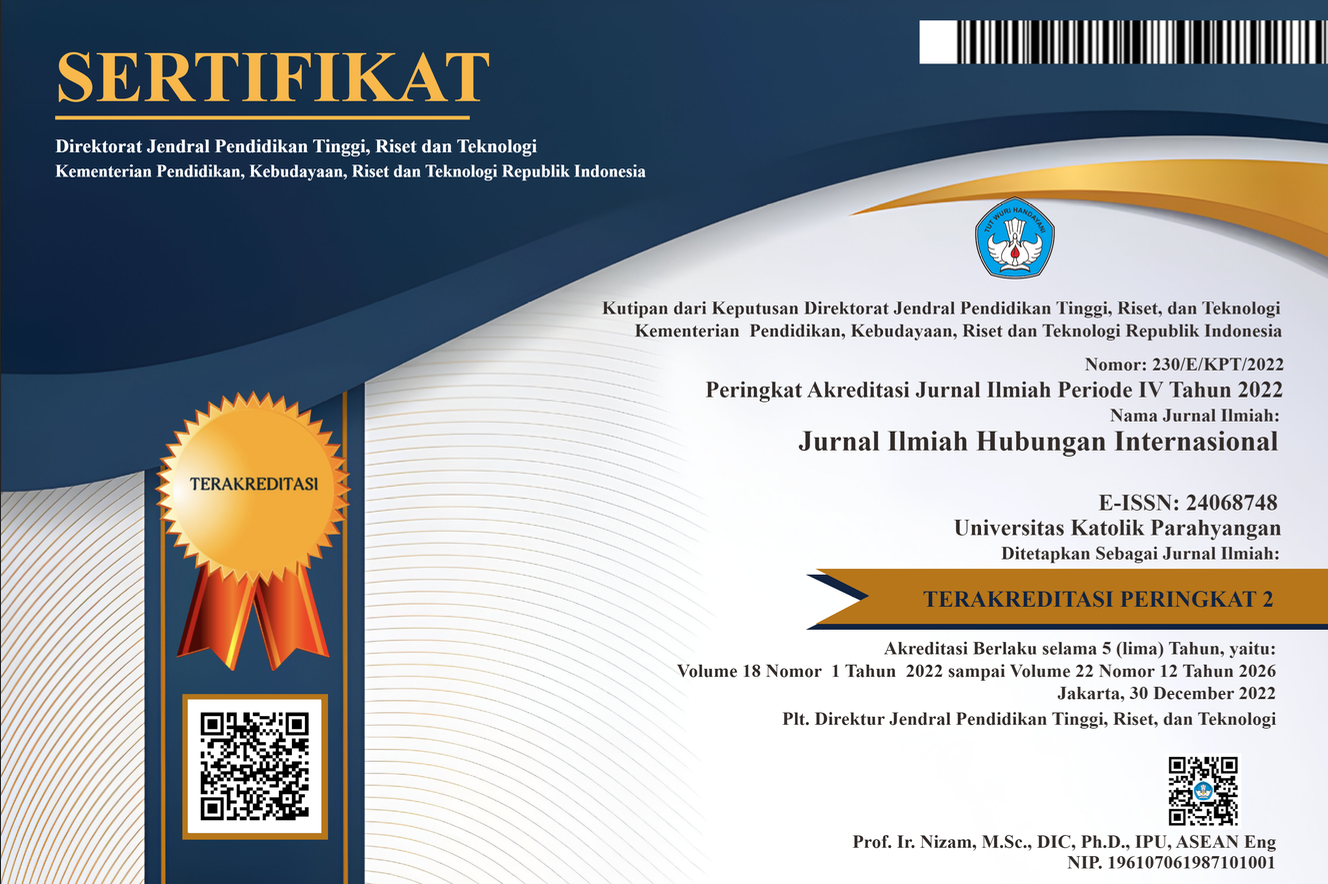Comparative Analysis of Indonesia-China High Speed Train and KTX Korea-France: A Sustainable Development for Locals or Reconfiguring Other Interests
DOI:
https://doi.org/10.26593/jihi.v17i1.3728.31-46Keywords:
China, High-Speed Train, Indonesia, Korea, CooperationAbstract
This study undermines a recent development of joint-cooperation between Indonesia and China regarding high-speed railway and its supporting constructions. New dedicated railway, train technology, and Transit Oriented Development (TOD) are part of the initial project, which planned concurrently along the projected area. All of these new railway and TODs are new and distant from already built residences and business centers. These study breakdowns how the Indonesia-China High Speed Train project were initiated and explaining vital factors that surrounds it. Reflecting on how Korea and France dealt with KTX (Korean Train Express) project, the TODs, railways, and train technology compare to Indonesia-China High Speed Train project, Indonesia-China project appears not sustainable and driven by other political and economical will.
References
Cadena, A., Dobbs, R., & Remes, J. (2012). The Growing Economic Power of Cities. Journal of International Affairs, 65(2), 1-17. Retrieved from
http://www.jstor.org/stable/24388214 (Accessed on July 10, 2019)
Chang, Iljoon and Gang‐len Chang. (2004). A network‐based model for estimating the market share of a new high‐speed rail system. Transportation Planning and Technology, 27:2, 67-90, DOI: 10.1080/0308106042000218186
Conolly, Helen. (2004). KTX Opens for Commercial Service.
https://www.alstom.com/press-releases-news/2004/4/KTX-opens-for-commercial- service-20040401 (Accessed on July 17, 2019)
DoDo. (2010). KTX: of delays and ambitions.https://www.eurotrib.com/story/ 2010/10/30/20724/383 (Accessed on July 19, 2019)
Falconer, Ryan and Emmerson Richardson. (2010). Rethinking urban land use and transport planning – opportunities for transit oriented development in Australian cities case study Perth. Australian Planner, 47:1, 1-13, DOI: 10.1080/07293680903510519
Hisung Lee and Dae-Sop Moon. (2005). Next Generation of Korean Train Express (KTX): Prospect and Strategies. Eastern Asia Society for Transportation Studies, Vol. 5, pp. 255 - 262.
Huang, Wencheng and Bin Shuai. (2019). Approach and application on high-speed train stop plan for better passenger transfer efficiency: the China case. International Journal of Rail Transportation, 7:1, 55-78, DOI: 10.1080/23248378.2018.1489741
Kementerian Hukum dan HAM Republik Indonesia. (2016). Perpres No.3/2016. Jakarta.
Kementerian Hukum dan HAM Republik Indonesia. (2008). Peraturan Pemerintah [PP] No. 26/2008. Jakarta.
Kim, Jin. (2007). Discriminant Impact of Transit Station Location on Office Rent and Land Value in Seoul: An Application of Spatial Econometrics. Journal of Transport Economics and Policy. 41. 219-245.
KS PusLit BKD. (2016). Kontroversi Izin Lingkungan Proyek Kereta Cepat Jakarta-Bandung. https://www.academia.edu/28836139/04_Kontroversi_Izin_Lingkungan_Proyek_
Kereta_Cepat_Jakarta-Bandung (Accessed on July 12, 2019)
Kuo, M. A. (2019). Jokowi 2.0: Indonesia Amid US-China Competition. Retrieved from https:// thediplomat.com/2019/11/jokowi-2-0-indonesia-amid-us-china-competition/. (Accessed on November 30, 2019)
Lavery, Thomas and Pavlos Kanaroglou. (2012). Rediscovering light rail: assessing the potential impacts of a light rail transit line on transit oriented development and transit ridership. Transportation Letters, 4:4, 211-226, DOI: 10.3328/TL.2012.04.04.211-226
Lim, S. (2015). How Beneficial Would the Construction of a Rason-Hunchun Sub-Regional Economic Cooperation Zone in the Northeast Asian Borderlands Be? North Korean Review, 11(1), 63-81. Retrieved from http://www.jstor.org/stable/43908956 (Accesed on July 15, 2019)
Nam-Geon Cho and Jin-Kyu Chung. (2008). High speed rail construction of Korea and its impact. KRIHS Special Report Series. Korea Research Institute for Human Settlements. Anyang.
Prasetiyo, B. (2016). Pengamat: Proyek Kereta Cepat Merusak Lingkungan. Retrieved from https:// bisnis.tempo.co/read/738527/pengamat-proyek-kereta-cepat-merusak-lingkungan.
(Accessed on July 12, 2019)
PT. Kereta Cepat Indonesia Cina. (2016). Konsep Pembangunan Terintegrasi.
http://kcic.co.id/konsep-pembangunan-terintegrasi/ (Accessed on July 13, 2019)
Renne, John L. (2009). From transit-adjacent to transit-oriented development. Local Environment, 14:1, 1-15, DOI: 10.1080/13549830802522376
Rezkisari, Indira. (2015). Bangun Kereta Cepat, Konsorsium BUMN-Cina Dibentuk. https://republika.co.id/berita/ekonomi/makro/15/10/16/nwarda328- bangun-kereta-cepat- konsorsium-bumn-cina-dibentuk (Accessed July 24, 2019).
Robertson, Simon. (2013). High-speed rail's potential for the reduction of carbon dioxide emissions from short haul aviation: a longitudinal study of modal substitution from an energy generation and renewable energy perspective. Transportation Planning and Technology, 36:5, 395-412, DOI: 10.1080/03081060.2013.818271
Salim, Wilmar and Siwage Dharma Negara, (2016). Why is the High-Speed Rail Project So Important to Indonesia? ISEAS Perspective No.16, 2016.
Singh, Jasjit and Matt Marx. (2012). Geographic Constraints on Knowledge Spillovers: Political Borders vs. Spatial Proximity. INSEAD.
Sunduck D.Suh. (2000). RISK MANAGEMENT IN A LARGE-SCALE NEW RAILWAY TRANSPORT SYSTEM PROJECT: Evaluation of Korean High Speed Railway Experience. IATSS Research Volume 24, Issue 2, 2000, Pages 53-63.
https://doi.org/10.1016/S0386-1112(14)60029-7 (Accessed July 22, 2019).
Sutianto, Feby Dwi. (2016). Pengembang Kereta Cepat Jakarta-Bandung Suntik Modal Rp 1,25 T.
https://finance.detik.com/berita-ekonomi-bisnis/d-3116023/pengembang-kereta-cepatjakarta- bandung-suntik-modal-rp-125-t [Accessed April 3, 2019].
Syailendra, E. A. (2015). Indonesia’s High Speed Rail:A China-Japan Scramble for Influence? RSIS Commentary No. 269–9 December 2015.
http://futuredirections.org.au/wp-content/uploads/2016/01/CO15269.pdf
(Accessed on July 23, 2019,)
Won, J. (1990). Multicriteria Evaluation Approaches to Urban Transportation Projects. Urban Studies, 27(1), 119-138. Retrieved from http://www.jstor.org/stable/43084074 (Accessed, July 20, 2019)
Yang, Katie and Dorina Pojani. (2017). A Decade of Transit Oriented Development Policies in Brisbane, Australia: Development and Land-Use Impacts. Urban Policy and Research, 35:3, 347-362, DOI: 10.1080/08111146.2017.1294537
Yafei, H. (2014. China's Overcapacity Crisis Can Spur Growth Through Overseas Expansion. https://www.scmp.com/comment/insight-opinion/article/1399681/chinas-overcapacity-crisis-can-spur-growth-through-overseas (Accessed on July 22, 2019,)
Downloads
Published
How to Cite
Issue
Section
License
Copyright (c) 2021 Jurnal Ilmiah Hubungan Internasional

This work is licensed under a Creative Commons Attribution 4.0 International License.
This journal uses Creative Commons license (CC BY). We allow readers to read, download, copy, distribute, print, search, or link to the full texts of its articles and allow readers to use them for any other lawful purpose. The author must be aware that the article copyrights will be fully transferred to Jurnal Ilmiah Hubungan Internasional only if the article is accepted to be published in the journal through signing of the Copyrights Transfer Agreement. Authors are allowed to resend their manuscript to another journal or intentionally withdraw the manuscript only if both parties (JIHI and Authors) have agreed on the related issue. Once the manuscript has been published, authors are allowed to use their published article under Jurnal Ilmiah Hubungan Internasional copyrights.








